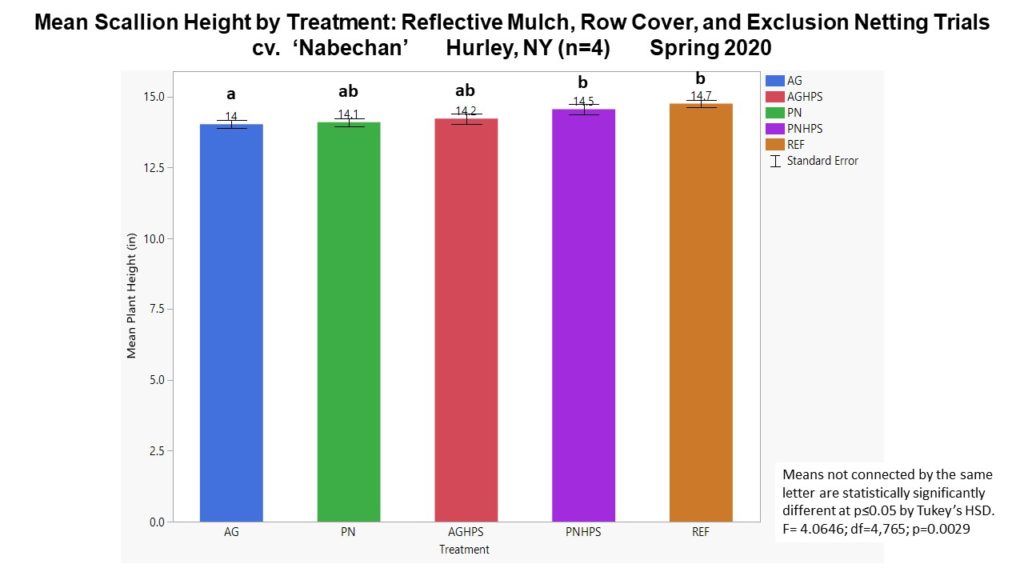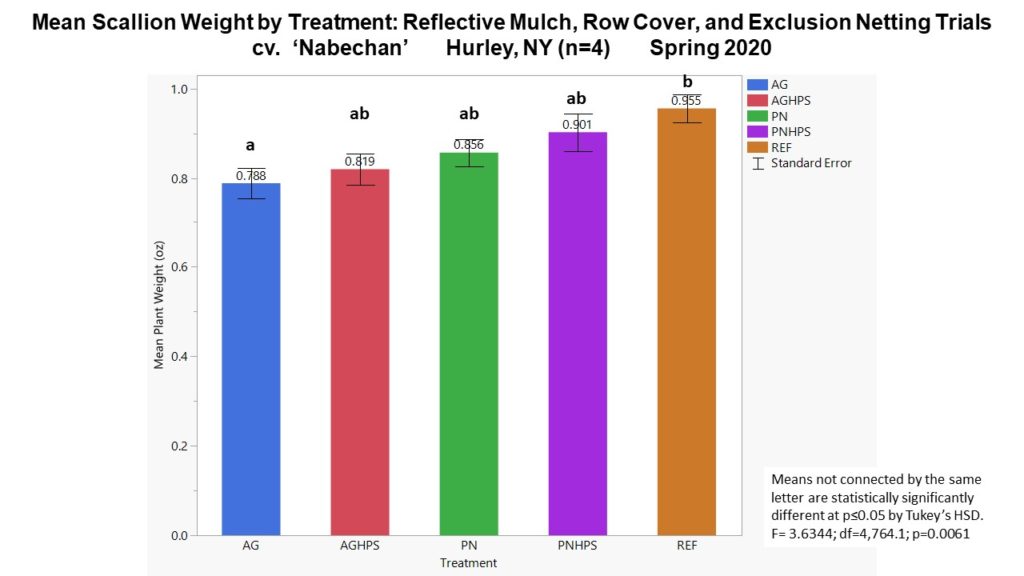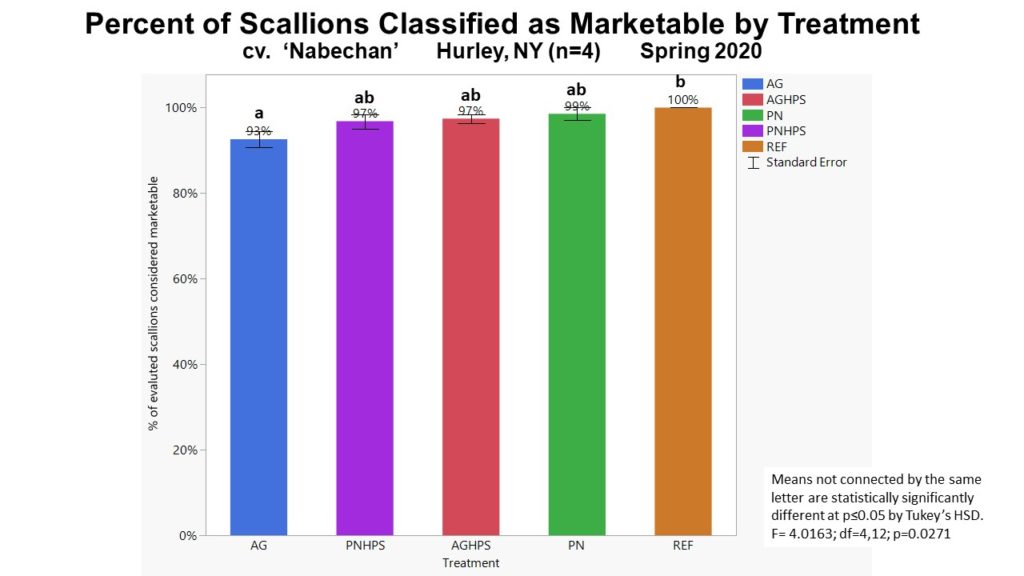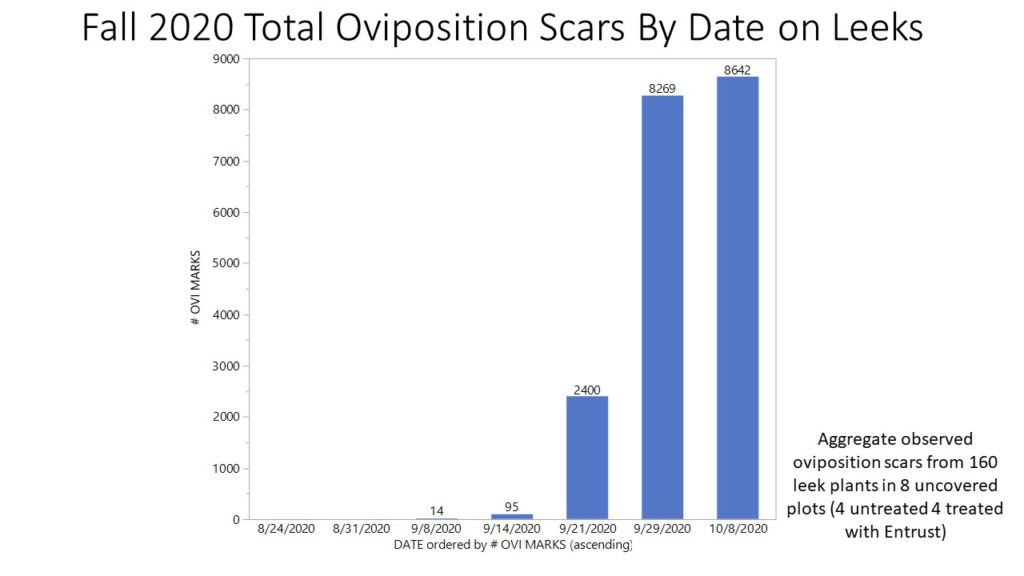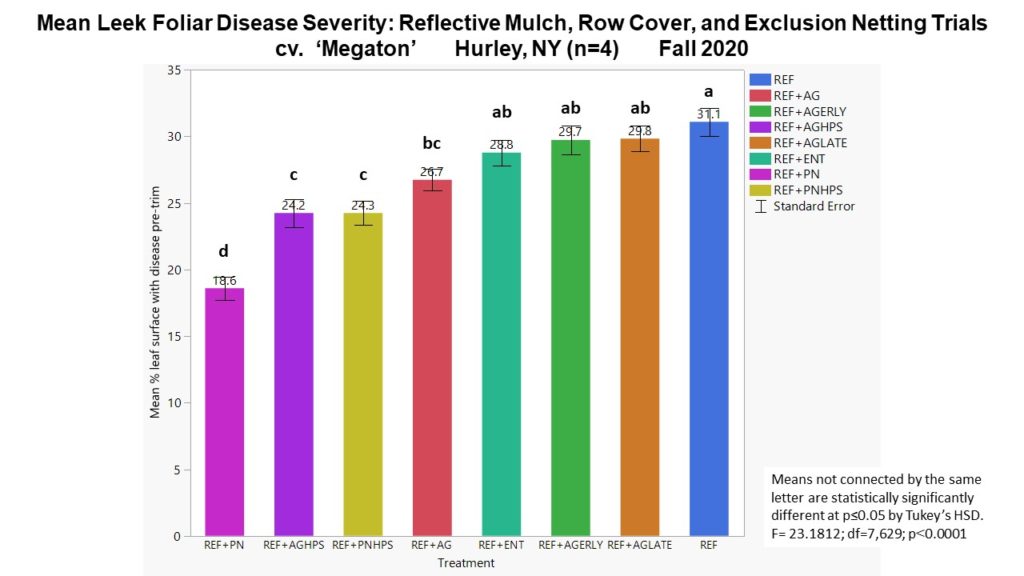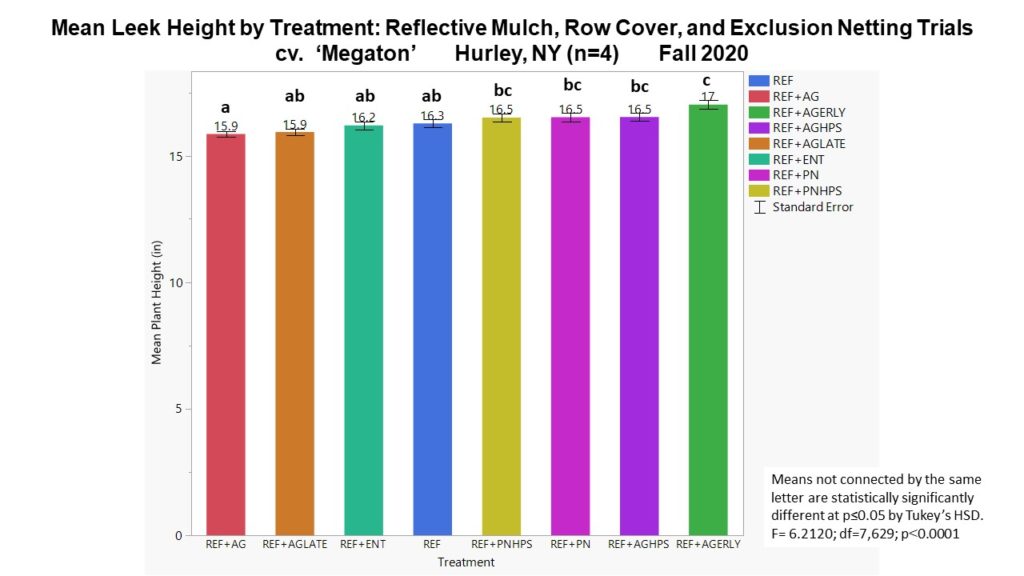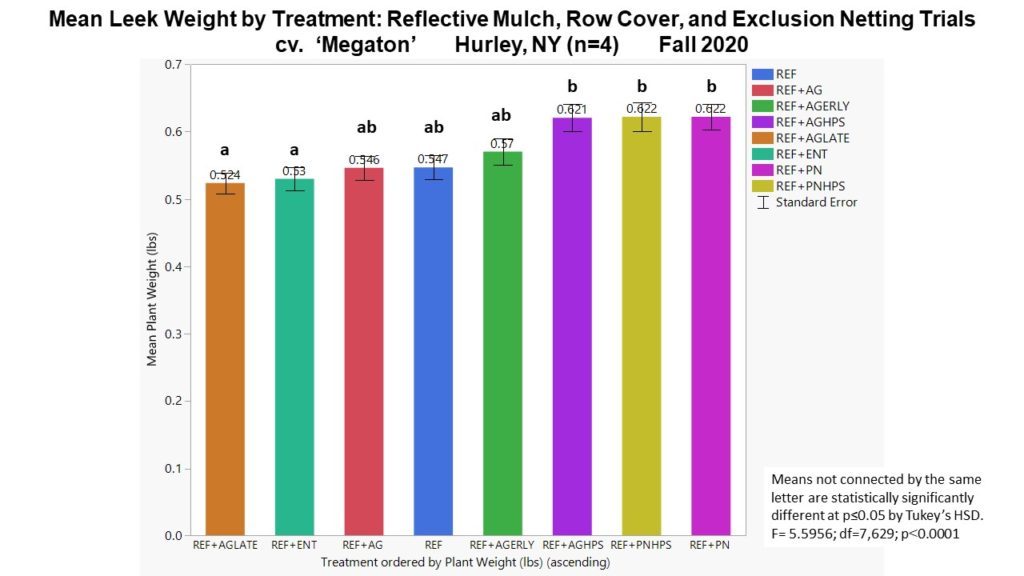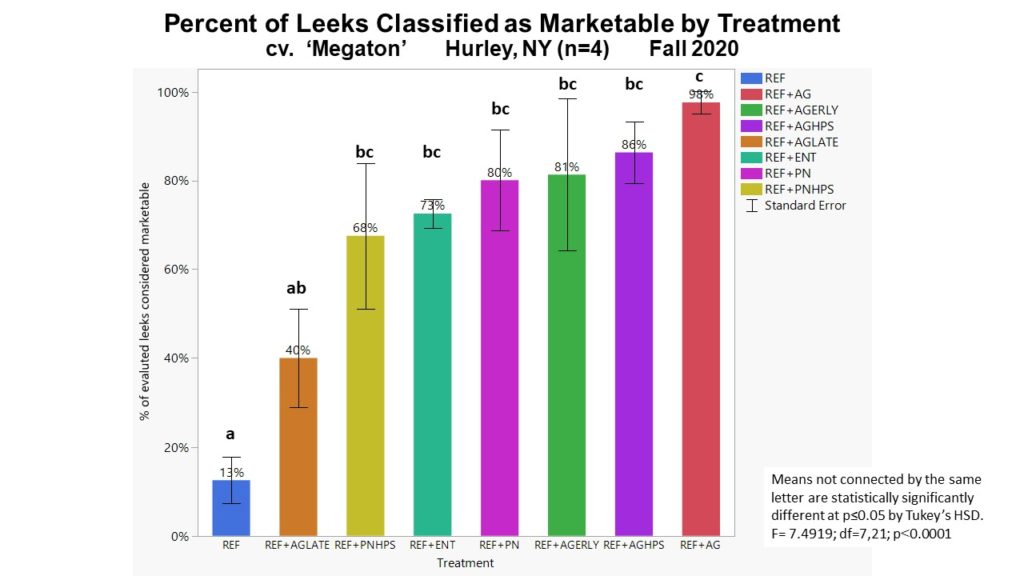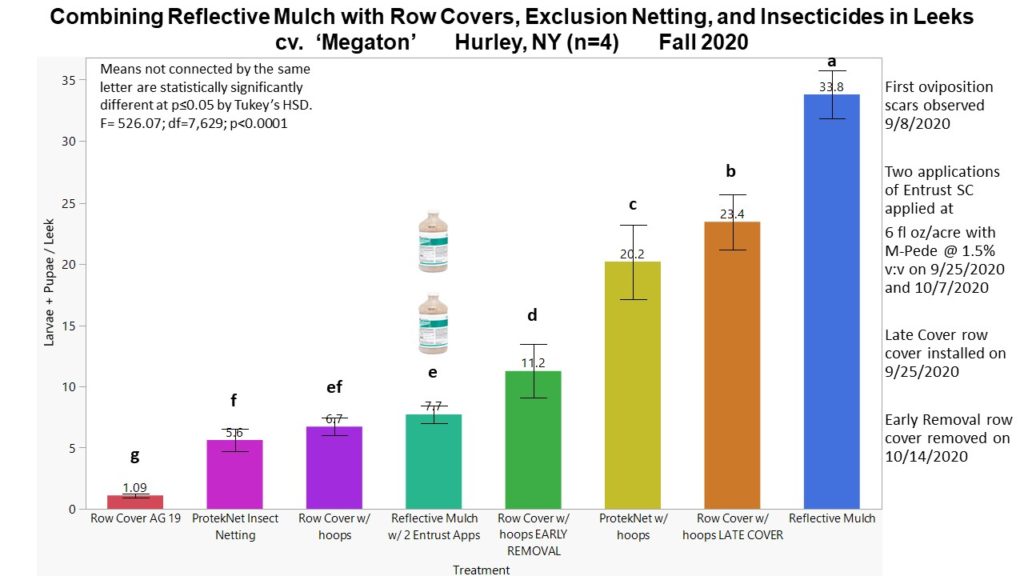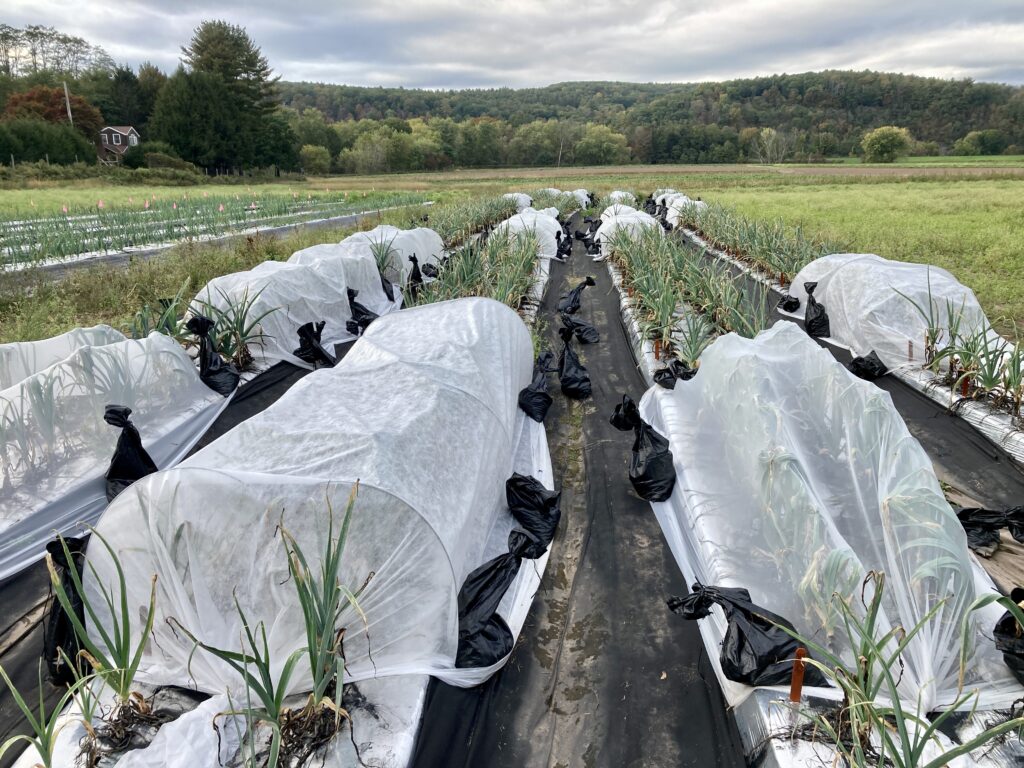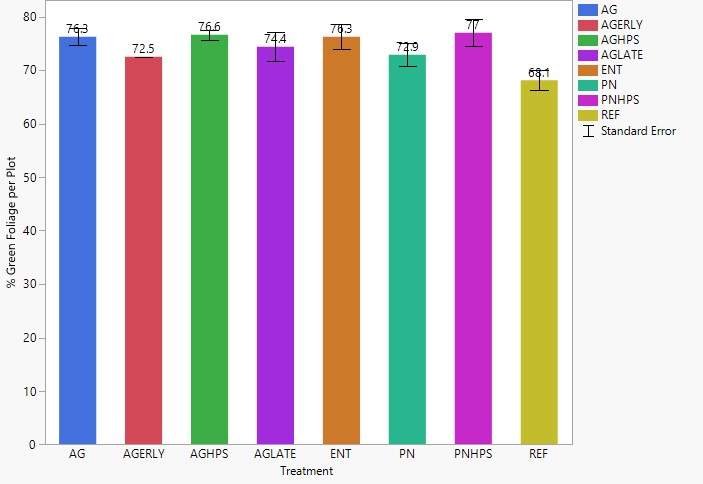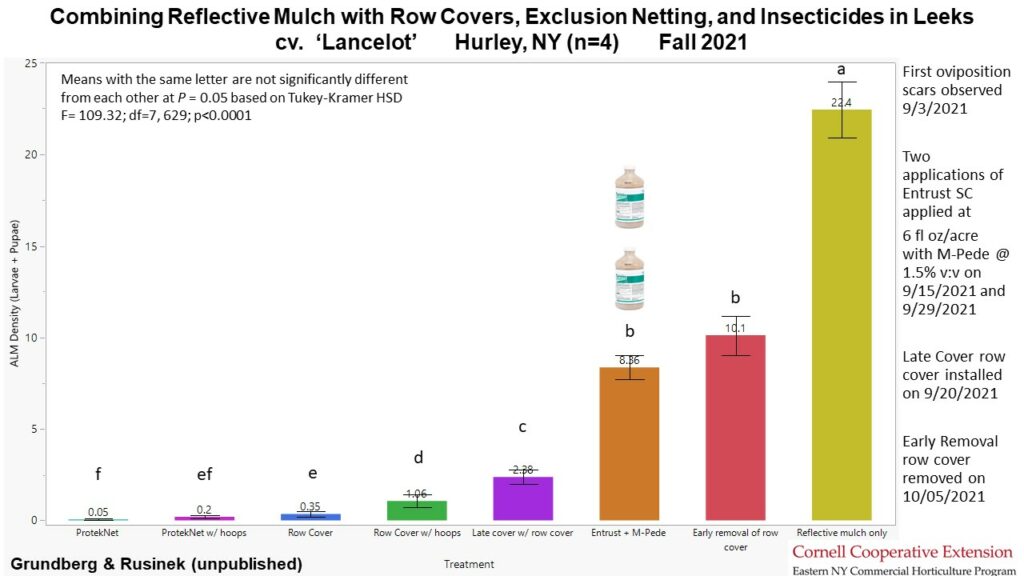Final report for ONE19-336
Project Information
Small plot randomized complete block design field trials with four replications were conducted to evaluate the efficacy of row cover, insect netting, and OMRI-listed insecticide applications in reducing damage from the new insect pest the allium leafminer (ALM) to leeks. Research conducted in Hurley, NY in 2020 and 2021 found that two well-timed applications of Entrust SC with M-PEDE on leeks grown on reflective plastic mulch reduced ALM densities by between 63% and 71% compared to the untreated control, but failed to reduce damage to an acceptable level. Leek plots that were well-covered for the entire duration of the fall ALM flight (approximately 8 weeks) with either insect netting or floating row cover produced the crop with the lowest ALM densities in 2021 (all below 1.1 maggots and pupae per leek). There was no statistically significant difference in marketable yield or disease severity between the floating row cover treatments and the insect netting treatments, suggesting that either material can be used to effectively exclude ALM adults from feeding on allium crops. The findings of this research were shared with an estimated 3,518 farmers and technical assistance providers in the Northeast through published newsletter articles, a podcast episode, and multiple webinars.
This project seeks to answer the following questions:
1) Can the combined use of reflective mulch and a single OMRI-approved insecticide application serve as a viable alternative to the use of row covers to reduce damage from ALM on commercial farms in the northeast?
2) What, if any, increase in marketable yield can allium growers in the region expect from the addition of an insecticide application to the cultural control approach of just using metalized reflective mulch?
3) Does the additional expense of purchasing insect exclusion netting result in an increase in marketable allium yield when compared to the use of floating row cover to protect plants from ALM adults?
4) Can growers apply row covers to allium crops for only a portion of the adult ALM flight to reduce negative impacts to yield and quality while maintaining protection from ALM damage?
If the project is successful, farmers in the region will gain access to research based recommendations on how to reduce damage to high value allium crops from ALM. The input expenses, labor tracking, and marketable yield data analyzed and interpreted will empower growers to make more informed decisions about sustainable management of ALM in the future.
Tim Elkner, Penn State Cooperative Extension, and Dr. Shelby Fleischer, Penn State University Department of Entomology, spent the fall of 2017 evaluating insecticides to reduce ALM damage on leeks. The preliminary results from the trial found that foliar applications of dinotefuran (Scorpion 35 SL) and cyantraniliprole (Exirel) both provided a statistically significant reduction in ALM damage compared to the OMRI-approved insecticide azadirachtin (Aza-Direct) and the untreated control (Fleischer 2017, Personal Correspondence). However, dinotefuran is not registered for use in several Northeastern states including New York and Exirel is only available with a 2ee SLN label for use on bulb crops for dipteran leafminer management in NY.
With support from the Foundation for Food and Agriculture Research Rapid Outcomes from Agricultural Research program and the New York Farm Viability Institute, Grundberg and Rusinek collaborated with Dr. Brian Nault, Cornell University Department of Entomology, on further insecticide evaluations for ALM management in 2017 and 2018. The 2018 trials located in Red Hook, NY did yield promising preliminary results from the evaluation of 14 insecticides (9 conventional, 4 OMRI-approved). Dr. Nault found that spring transplanted onions and fall transplanted scallions treated with six weekly applications of the OMRI-approved insecticide Entrust SC (spinosad) mixed with M-Pede (potassium salts of fatty acids) achieved comparable levels of reduction of ALM damage to four conventional chemistries (Nault and Grundberg 2019). These trials were not, however, designed to generate recommendations for growers that could be adopted immediately to manage ALM. Products like Entrust SC have labeled resistance management restrictions that require rotation to products with different modes of action after two sequential applications. Even if six sequential applications of the insecticide were permissible, the recommendation would not be cost effective for most commercial allium growers.
Grundberg and Rusinek conducted a randomized complete block design trial to evaluate the efficacy of different timing sequences of just two applications of Entrust SC mixed with M-Pede on leeks during the fall ALM flight. The trials, which were supported by funding from the New York State Department of Agriculture and Markets, did demonstrate statistically significant differences between the different timing sequences of insecticide application during the six-week ALM flight period. The preliminary results suggest that making two applications of Entrust SC with M-Pede two to four weeks after first observed ALM activity can provide a comparable reduction in damage from ALM to six weekly applications of the same product mix (Nault and Grundberg 2019).
While the majority of the research to date in the United States has focused on chemical controls for ALM management, there has been some work done to evaluate the potential for cultural control strategies to mitigate ALM damage in Europe. There is mention in scientific literature of recommendations from Austria to use insect netting to cover leeks as a method to exclude adult ALM from laying eggs on host plants (Kahrer 1999). Unfortunately, there is no description of research that may have generated those recommendations or any data collected on costs or impact on marketable yield. Slovenian researchers conducted trials to determine whether interplanting aromatic herbs like oregano, lavender, and rosemary may reduce damage from ALM in onion fields. However, two years of replicated trials showed no statistically significant reduction in damage from ALM in interplanted plots and actually demonstrated a negative impact on marketable onion yield when interplanted with lavender (Laznik 2012).
Rusinek and Grundberg also conducted preliminary trials to evaluate the potential efficacy of metalized reflective mulch compared to white plastic mulch at reducing damage from ALM in both leeks and scallions in 2018. The research did find a statistically significant difference between the two plastic mulch treatments and a roughly 30% reduction in damage from ALM in the reflective mulch plots for both leeks and scallions. However, the mean number of ALM larvae and pupae per plant in the reflective mulch plots was still unacceptable at 2.95 per scallion and 9.32 per leek.
Grundberg and Rusinek also evaluated the combination of using reflective plastic mulch with either one or two carefully timed insecticide applications to see if there may be a synergy between the cultural and chemical control tactics to reduce damage from ALM. Initial results from those trials, conducted in spring 2019 on scallions and fall 2019 on leeks, suggest that the combination of two applications of Entrust with M-Pede 2 and 4 weeks after the beginning of the adult ALM flight with reflective plastic mulch can significantly reduce ALM damage to acceptable levels. In their trial on leeks in fall 2019, leeks receiving no insecticide on reflective mulch contained a mean number of ALM of 30.8, leeks receiving one insecticide application on reflective mulch contained a mean number of ALM of 11.5, while the treatment on reflective mulch with two applications of Entrust with M-Pede contained a mean number of ALM of just 2.72 (Grundberg and Rusinek, unpublished).
This proposal aims to fill in information gaps on the efficacy and costs of cultural control tactics like using different row covers to reduce damage from ALM. It also proposes to further evaluate the potential of combining the use of reflective mulch with reduced Entrust SC applications in hopes of generating cost-effective and adoptable management strategies for organic allium growers in the northeast.
Cooperators
- (Educator and Researcher)
Research
Introduction and Trial Design
The trial aims to evaluate the efficacy of different cultural and chemical control strategies in reducing crop damage caused by allium leafminer (ALM). Since there are two ALM generations per year, there are two separate trials proposed to evaluate the efficacy of treatments during each flight. During the spring ALM flight, transplanted ‘Nabechan’ scallions will be used as the host cash crop. For the fall ALM flight, transplanted ‘Megaton’ leeks will be used as the host cash crop. Both the spring and fall trials include the following 8 treatments:
- Reflective mulch (REF)- Scallions will be planted on reflective plastic mulch, but will not be covered and will not receive any insecticide applications.
- Reflective mulch plus insecticide (REF+ENT)- Scallions on reflective plastic mulch will receive two applications of Entrust SC (spinosad, IRAC group 5) at the 6 ounce per acre rate mixed with a 1.5% v/v dilution of M-Pede (potassium salts of fatty acids, not classified) 2 and 4 weeks after observing the first oviposition scars in the trial plot. The applications will be made using a CO2 –pressurized research backpack sprayer and boom equipped with twin flat-fan nozzles (TJ-60 8003VS) each positioned over a row and calibrated to deliver 46.87 gallons per acre of spray mixture at 39 PSI.
- Reflective mulch plus ProtekNet exclusion netting (REF+PN)- Scallions on reflective plastic mulch will be covered at transplant with 83-inch wide ProtekNet biothrips insect exclusion netting anchored with sand bags and will remain covered until the confirmed conclusion of the ALM flight. The exclusion netting in this treatment will not be supported by wire hoops.
- Reflective mulch plus ProtekNet with hoops (REF+PNHPS)- Same as treatment REF+PN, but with 76” high tensile steel hoops to support the netting above the crop canopy.
- Reflective mulch plus DeWitt 0.55 floating row cover (REF+AG)- Same as treatment REF+PN, but using 7-foot wide DeWitt 0.55 floating row cover (comparable to Agribon+ AG-19) instead of ProtekNet biothrips insect exclusion netting.
- Reflective mulch plus DeWitt 0.55 floating row cover with hoops (REF+AGHPS)- Same as treatment REF+PNHPS, but using DeWitt 0.55 floating row cover instead of ProtekNet biothrips insect exclusion netting.
- Reflective mulch plus DeWitt 0.55 floating row cover with hoops late cover (REF+AGLATE)- Same as treatment REF+AGHPS, but the floating row cover will not be installed at the time of transplant. Instead, row cover will be applied and secured two weeks after the observed ALM emergence date.
- Reflective mulch plus DeWitt 0.55 floating row cover with hoops early removal (REF+AGERLY)- Same as treatment REF+AGHPS, but the floating row cover will be removed prior to the end of the ALM flight. The exact timing of removal will be determined based on oviposition scouting data, but will likely occur approximately 4 weeks after ALM emergence.
Data Collection and Analysis
Oviposition scars made by ALM adults on leaf tissue will be counted weekly after ALM emergence on 20 randomly selected plants per plot for each treatment that is not covered. Oviposition scars will only be observed on a presence or absence basis per plot upon the removal of covers for the other treatments.
20 scallion bunches per plot, or 80 bunches per treatment, will be harvested for data analysis as soon as feasible after the end of the spring ALM flight. The number of individual scallion plants per bunch will be recorded to allow for analysis on a per plant basis. Each scallion will be measured, weighed, evaluated for foliar disease severity, and assessed for marketability. 20 leeks per plot, or 80 per treatments, will be harvested as soon as feasible after the end of the fall ALM flight. Each leek will be evaluated for foliar disease severity and marketability. Data will be analyzed using a general linear model of SAS or JMP 15.1.0 Pro Software (SAS Institute Inc.) with treatment as the fixed effect and replicate as a random effect. Yield, disease, and marketability data will be compared using a one-way ANOVA with Tukey’s Studentized Range (HSD) test at p < 0.05.
Once the aforementioned data has been collected for both scallions and leeks, the subsamples will be carefully dissected. All ALM larvae and pupae will be extracted and counted on a per plant basis during the dissection process. Larvae and pupae count data will be analyzed using a Poisson generalized linear model of SAS or JMP 15.1.0 Pro Software (SAS Institute Inc.). Means will be compared with Tukey’s Studentized Range (HSD) test at p < 0.05.
Details on each trial follow below.
SPRING 2020 SCALLION TRIAL: HURLEY, NY
Propagation and Planting Methods
'Nabechan' scallions were seeded at a rate of 3-4 seeds per cell in 200 cell propagation trays on February 19, 2020. The plugs were transplanted into 3 rows per bed with 6-inch in-row spacing onto reflective plastic mulch on April 6, 2020 in a small plot randomized complete block design with 8 treatments and 4 replicates. Each plot was 10 bed-feet long and consisted of 60 scallion plugs. Weed mat was secured between the rows of reflective plastic mulch with metal ground staples. Allium leafminer (ALM) oviposition scars were first observed in a garlic field approximately 2 miles from the trial plot location on April 8, 2020. The trial treatments requiring the installation of Dewitt .55 floating row cover or ProtekNet exclusion netting prior to the start of adult ALM activity (REF+PN, REF+PNHPS, REF+AG, REF+AGHPS, and REF+AGERLY) were covered on April 7, 2020 and secured using sandbags and ground staples.
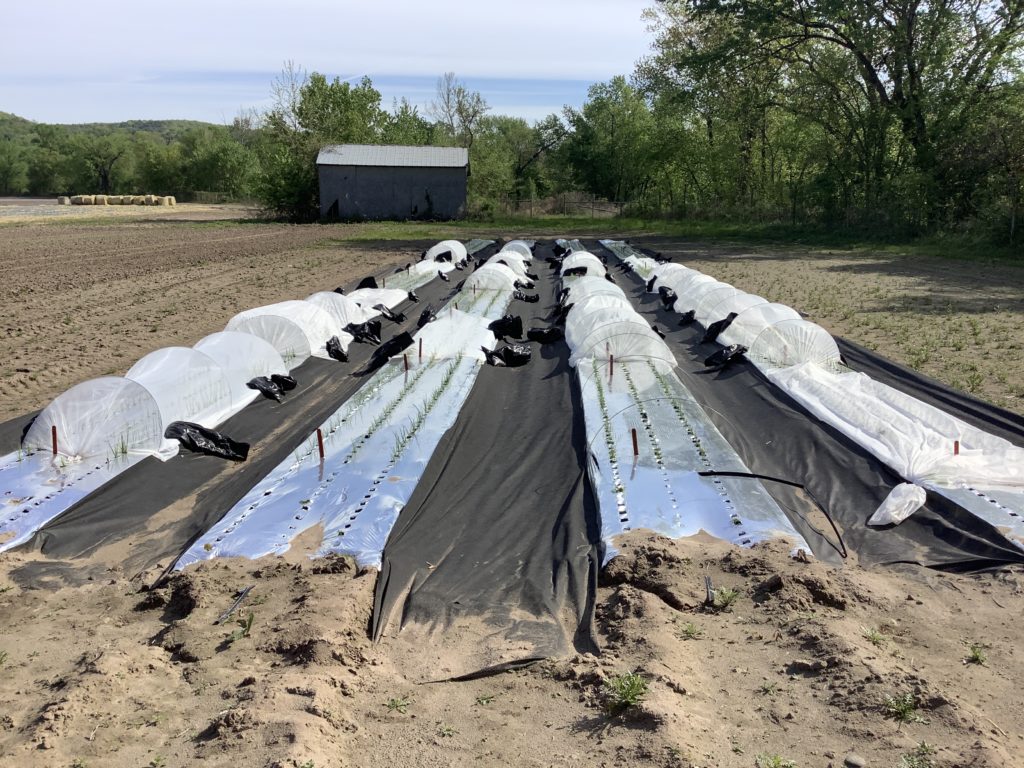
Harvest and Evaluation
Scallion harvest and evaluation began on June 16, 2020 and continued through June 19, 2020. Roots were trimmed from each plant prior to weighing. Each scallion was evaluated for marketability based on disease severity, size, and crop distortion.
FALL 2020 LEEK TRIAL: HURLEY, NY
Propagation and Planting Methods
‘Megaton’ leeks were seeded at a rate of 1 seed per cell in 200 cell propagation trays on March 26, 2020. The plugs were transplanted into 2 rows per bed with 6-inch in-row spacing onto reflective plastic mulch on June 16, 2020 after confirming the end of the spring ALM flight. The trial design was a small plot randomized complete block design with 8 treatments and 4 replicates. Each plot was 10 bed-feet long and consisted of 40 leek plants. Weed mat was secured between the rows of reflective plastic mulch with metal ground staples.
ALM oviposition scars were first observed in the trial field on September 8, 2020. The trial treatments requiring the installation of Dewitt .55 floating row cover or ProtekNet exclusion netting prior to the start of adult ALM activity (REF+PN, REF+PNHPS, REF+AG, REF+AGHPS, and REF+AGERLY) were covered on September 8, 2020 and secured using sandbags and ground staples. With the exception of REF+AGERLY, the covered plots were uncovered upon the confirmed completion of the fall ALM flight on November 6, 2020. Treatments using metal hoops were equipped with 2 76-inch hoops per arch to provide more space for crop development under the covers.
Row covers were removed from the 4 REF+AGERLY treatment plots on October 14, 2020 (approximately 2 weeks prior to the end of the fall ALM flight). Row covers were installed from the 4 REG+AGLATE treatment plots on September 25, 2020 (about 2.5 weeks after the start of the fall ALM flight) and left on until November 6, 2020. The leeks in the REF+ENT plots were sprayed with Entrust SC with M-Pede on September 25, 2020 and October 8, 2020.
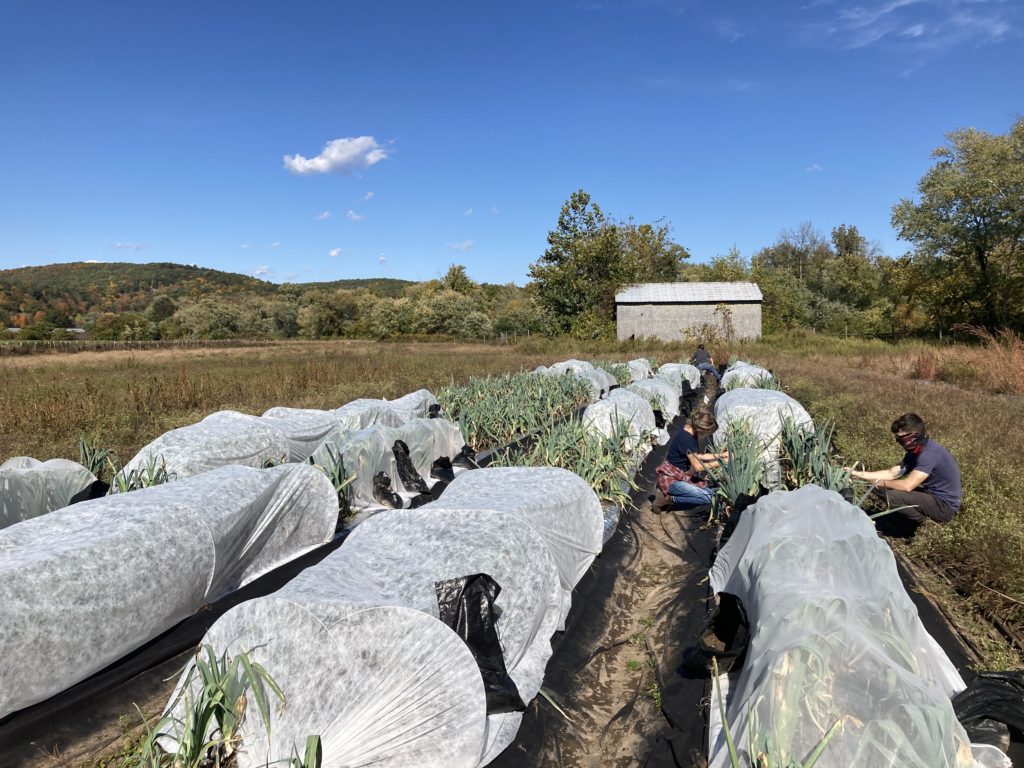
Harvest and Evaluation
Leek harvest and evaluation began on November 6, 2020 and continued through November 8, 2020. Each leek was evaluated for foliar disease severity prior to trimming roots and trimming the foliage at 6-inches from the top of the shaft. The leeks were then measured and weighed before being stored in a walk-in cooler at 33ºF. Leeks were removed from cold storage in batches to assess each plant for marketability and to quantify the number of ALM larvae and pupae per leek. The marketability assessment was made after stripping the outer 3 to 4 leaves and was based on visible ALM larvae and pupae, disease severity (primarily soft rot associated with ALM feeding damage), size, and distortion. ALM larvae and pupae were extracted from each leaf layer of the leek, including the leaves stripped for the marketability assessment, and recorded on a per plant basis.
Fall 2021 Leek Trial: Hurley, NY
Propagation and Planting Methods
‘Lancelot’ leeks (Bejo) were seeded at a rate of 1 seed per cell in 200 cell propagation trays on March 26, 2021. The plugs were transplanted into 2 rows per bed with 6-inch in-row spacing onto reflective plastic mulch on June 10, 2021 after confirming the end of the spring ALM flight. The trial design was a small plot randomized complete block design with 8 treatments and 4 replicates. Each plot was 10 bed-feet long and consisted of 40 leek plants. Weed mat was secured between the rows of reflective plastic mulch with metal ground staples.
ALM oviposition scars were first observed in the trial field on September 3, 2021. The trial treatments requiring the installation of 10-foot wide Dewitt .55 floating row cover or 10-foot wide ProtekNet exclusion netting prior to the start of adult ALM activity (REF+PN, REF+PNHPS, REF+AG, REF+AGHPS, and REF+AGERLY) were covered on September 7, 2021 and secured using sandbags and ground staples. With the exception of REF+AGERLY, the covered plots were uncovered upon the completion of the fall ALM flight on November 2, 2021.
Row covers were removed from the 4 REF+AGERLY treatment plots on October 5, 2021 (approximately 4 weeks prior to the end of the fall ALM flight). Row covers were installed in the 4 REG+AGLATE treatment plots on September 20, 2021 (about 2.5 weeks after the start of the fall ALM flight) and left on until November 2, 2021. The leeks in the REF+ENT plots were sprayed with Entrust SC (6 fl oz/acre) with M-Pede (1.5% v/v) on September 15, 2021 and September 29, 2021.
Harvest and Evaluation
Leek harvest and plot disease severity evaluations were completed on November 2, 2021. Twenty leeks per plot were harvested before trimming roots and trimming the foliage at 6-inches from the top of the shaft. The 20 leeks were then weighed together before being stored in a walk-in cooler at 33ºF. Leeks were removed from cold storage in batches to assess each plant for marketability and to quantify the number of ALM larvae and pupae per leek. ALM larvae and pupae were extracted from each leaf layer of the leek and recorded on a per plant basis.
The results of the spring scallion and fall leek trials will be discussed separately below.
SPRING 2020 SCALLION TRIAL
ALM Flight and Oviposition Activity
Despite confirming adult ALM activity on garlic in the vicinity and a history of ALM pressure on the host farm, no oviposition scars were observed in the scallion trial plot in spring 2020. The absence of ALM activity in the trial plot was unanticipated; however, there are several possible explanations:
- Lower ALM Pressure in the Spring: Researchers in PA and NY have observed that the spring ALM flight typically results in less crop damage than the fall ALM flight. Though Grundberg and Rusinek had documented ALM densities of up to 0.917 per 'Nabechan' scallion in a spring 2019 trial at a neighboring farm, the density in a similar trial in fall 2020 on 'Nabechan' scallions resulted in a mean ALM density of nearly 14 per scallion. Many commercial farms in the region reported no signs of ALM damage in the spring of 2020.
- Late Transplant Date: Partially due to an abnormally cool and overcast early spring, the scallion plugs were not ready for transplant in late March. The means by which adult ALM identify suitable host crops for feeding and egg laying is still not well understood; however, it is possible that the transplant date just 2 days prior to the first observed oviposition scars in the region may have resulted in smaller plants with a less-developed plant volatile profile that was less attractive to emerging ALM adults.
- Efficacy of Reflective Mulch: Previous research by Grundberg and Rusinek has documented a decrease in 25%-50% of ALM densities in allium crops grown on reflective plastic mulch when compared to the same crop grown on white or black plastic mulch in randomized complete block design trials. The researchers had not yet evaluated ALM densities in trials planted entirely on reflective plastic mulch until Spring 2020; it is possible that the deterrence mechanism that has produced the decrease in ALM densities in crops planted on reflective mulch in the past was amplified in Spring 2020 since there was no alternative crop planted on black plastic in the trial plot, thereby reducing ALM densities to 0.
Treatment and Methods Changes
Since there was no ALM activity in the spring trial plot, three of the treatments were eliminated from the scallion trial:
- REF+ENT- without ALM activity, there would be no difference in ALM density between the REF treatment and the REF+ENT treatment, so only the REF treatment was kept.
- REF+AGLATE- without ALM activity, there would be no difference in ALM density between the REF+AGHPS treatment and REF+AGLATE.
- REF+AGERLY- similarly to REF+AGLATE, there was no difference between REF+AGHPS and REF+AGERLY without ALM activity.
The absence of ALM activity also informed the elimination of the scallion dissection to quantify ALM densities per scallion across the treatments. Without any ALM activity in the plot, all ALM densities would have been 0.
However, the research questions regarding the potential impacts of row cover compared to exclusion netting and the use of hoops to support the covers on marketable yield could still be answered without ALM activity. Therefore, the methods outlined above to measure crop weight, height, disease severity, and marketability were used to evaluate the scallions in the remaining 5 treatments: REF, REF+PN, REF+PNHPS, REF+AG, and REF+AGHPS.
Scallion Quality and Yield
In mid-May 2020, sun scald was observed on approximately 15% of the scallions in the uncovered REF treatment plots. During the cool and overcast spring, the tender scallion transplants did not produce as much of a waxy cuticle that acts as a leaf protectant as they would in a typical spring. During the infrequent periods of full sun, those scallions were more susceptible to sun scald with the added UV being reflected from the reflective mulch than the scallions under cover. However, the early observations of sun scald did not appear to impact marketable yield or crop quality at harvest in mid-June.
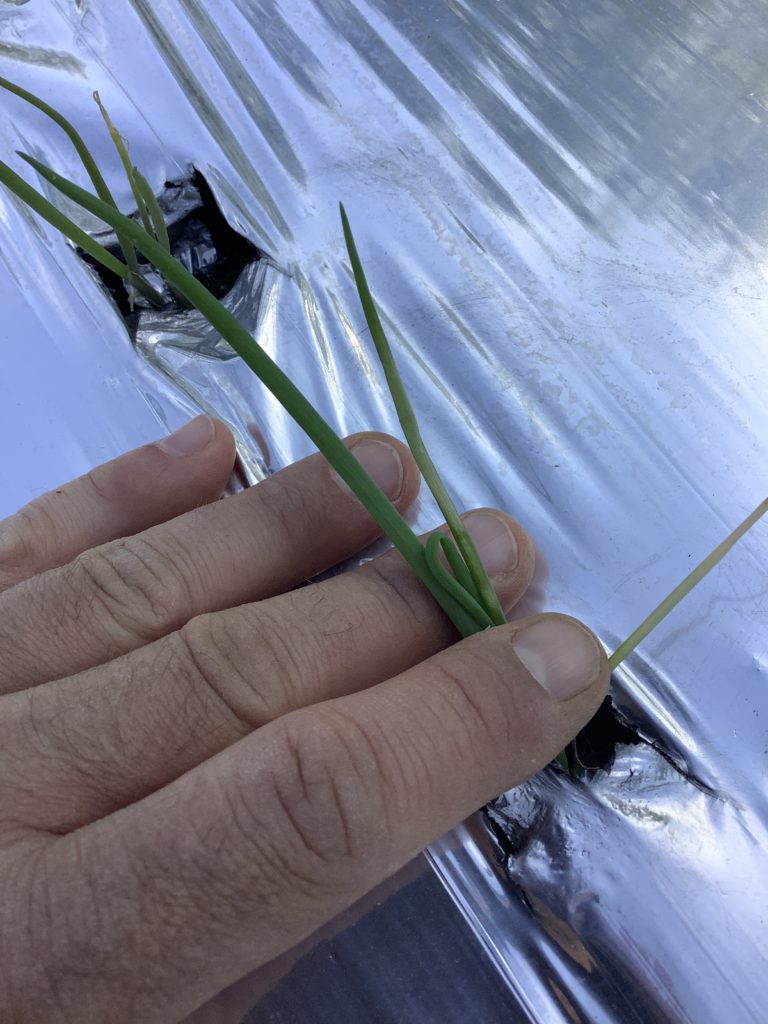
The row cover and exclusion netting was removed from all plots on June 6, 2020. After the covers were removed, visible distortion of the scallions in the treatment plots without hoops (REF+PN and REF+AG) was noted where the scallion growth had been impeded by the cover.
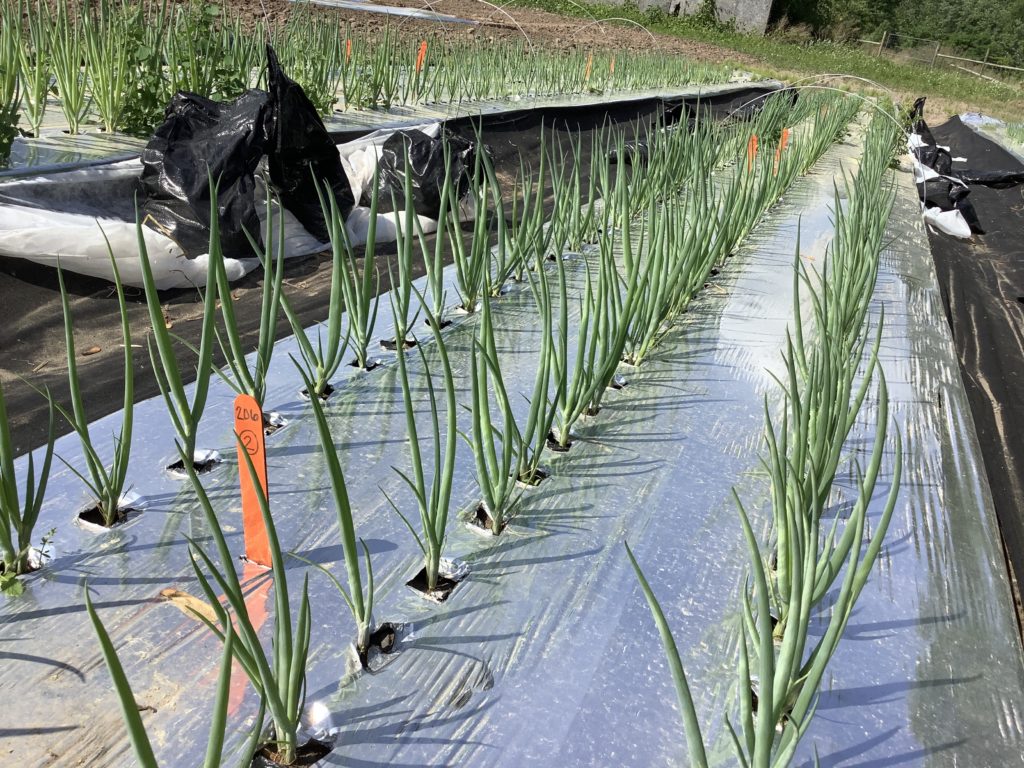
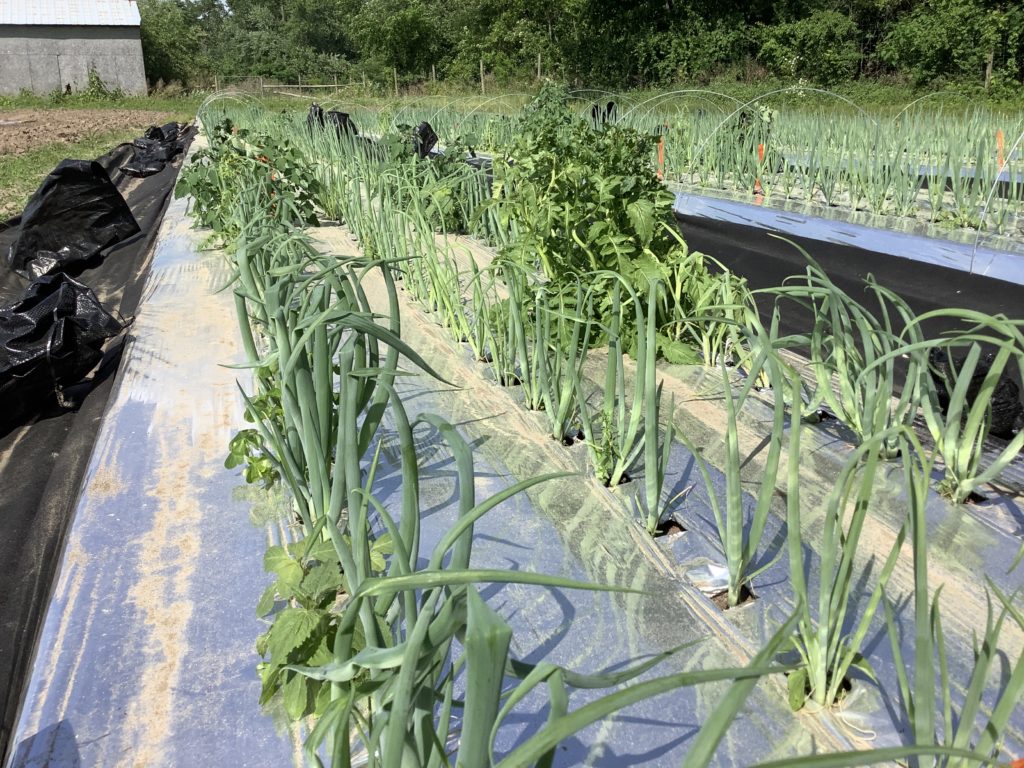
Crop Height
There was a statistically significant effect of the treatment on mean scallion height in the trial (see graph for details). The scallions in the REF+AG plots were numerically the shortest with a mean of 14 inches at harvest and were statistically significantly different from the REF+PNHPS and REF treatment scallions. The trends observed in the data suggest that using row cover or exclusion netting without hoops for support may reduce the mean height of scallions at harvest.
Crop Weight
There was also a statistically significant effect of the treatment on mean scallion weight in the trial (see graph for details). Just as the scallions in the REF+AG plots were numerically the shortest, they were also numerically the lightest in weight and were statistically significantly different from the REF treatment scallions. Though growers often use row cover in the spring to accelerate crop growth, the REF+AG and REF+AGHPS treatments had numerically the lowest mean yield by weight in the trial at 0.788 oz and 0.819 oz per scallion respectively, while the uncovered REF scallions were the heaviest at 0.955 oz per scallion. It is possible that the anticipated effects of row covers were negated by the use of reflective plastic mulch. Reflective plastic mulch has been shown to keep soil temperatures cooler in the spring by reflecting UV radiation that may otherwise warm the soil. Using row covers further reduces the UV radiation coming into contact with the plastic mulch and soil, which may have further suppressed soil temperatures in the covered treatments.
Disease Severity
As is often the case with spring grown scallions, disease pressure was extremely low across all of the treatments. Therefore, no statistically significant difference in disease severity was measured between treatments.
Percent Marketable Yield
There was a statistically significant effect of the treatment on the mean percent of scallions that were graded as “marketable” in the trial (see graph for details). The percentage of scallions harvested from the REF+AG plot that were considered marketable was the lowest of any treatment at 93% and statistically significantly different from the percent marketable crop harvested from the REF treatment plots. Of the 24 total scallions that were considered unmarketable across all treatments, 11 were distorted as described above. This was a surprisingly low figure given the severity of distortion when covers were removed on June 6, 2020. However, most of the scallions in the REF+AG and REF+PN treatments straightened up and grew out of the distortion during the nearly 2 week period after covers were removed before the scallions were ready to harvest and evaluate. The second most common cause for judging scallions as unmarketable in the trial was being undersized. Of the 24 unmarketable scallions across all treatments, 8 were deemed too small (less than 10 inches tall).
Summary
There was no discernable benefit to using exclusion netting instead of row cover in terms of disease severity, total crop yield, or percent marketable yield in the spring scallion trial. Using row cover without hoops for support resulted in the lowest yield and lowest percent marketable yield of all of the treatments. When ALM pressure is not a concern in the spring, the data from this trial would suggest that leaving scallions grown on reflective plastic mulch uncovered may be the best strategy for maximizing yield.
FALL 2020 LEEK TRIAL
ALM Flight and Oviposition Activity
As was mentioned above in the Materials and Methods section, ALM oviposition scars were first identified in the fall leek trial plot on September 8, 2020, suggesting the start of the fall ALM flight. The team recorded the number of oviposition scars on 20 randomly selected leeks in the REF and REF+ENT treatments weekly from August 24, 2020 through October 8, 2020. As can be seen in the graph below, the largest increase in oviposition scars occurred between weeks 2 and 3 (September 14 and September 21, 2020) and weeks 3 and 4 (September 21 and September 29, 2020). This data showing the periods of highest adult ALM activity during the fall flight correspond well to similar data collected in 2018 and 2019 by Grundberg and Rusinek. The data also helped to inform the application timing of the Entrust SC and M-PEDE in the REF+ENT treatment. By applying the insecticides in weeks 2 and 4 after the flight began (September 25, 2020 and October 8, 2020) in response to the peaks in ALM activity, it was hoped that the products would come into contact with the highest proportion of ALM in the REF+ENT plots and achieve the highest possible reduction in ALM damage for a 2 application sequence.
Treatment and Methods Changes
Row cover and exclusion netting in the REF+PN, REF+PNHPS, REF+AG, REF+AGHPS, and REF+AGERLY treatments were installed on September 8, 2020. Though the initial intent was to use a 3 single metal hoops to support the covers in the REF+PNHPS, REF+AGHPS, and REF+AGERLY plots, the leeks were already too tall for a single hoop system to provide enough vertical clearance. In response, 3 pairs of 2 hoops placed side by side with each hoop straddling the area from opposite edges of the bed to the center per 10 foot long plot were installed instead (see the image above in the Materials and Methods section). While this strategy did increase the amount of vertical space provided to the leeks under the covers, it also made the covers more difficult to anchor and more prone to slipping up the hoops leaving exposed gaps on the edges. Any grower who has used row covers extensively is keenly aware of the challenge of keeping the covers well anchored, especially in windy fields. As will be seen below, the efficacy of the covered treatments in reducing ALM densities at harvest was undoubtedly compromised by the inability to keep the edges well anchored. For growers interested in covering a single bed of leeks in the fall, a wider cover or netting would likely be more easily anchored than the 7 foot wide row cover and 6 foot 11 inch wide ProtekNet used in this trial. Wider row cover and ProtekNet would, however, be more expensive per bed foot.
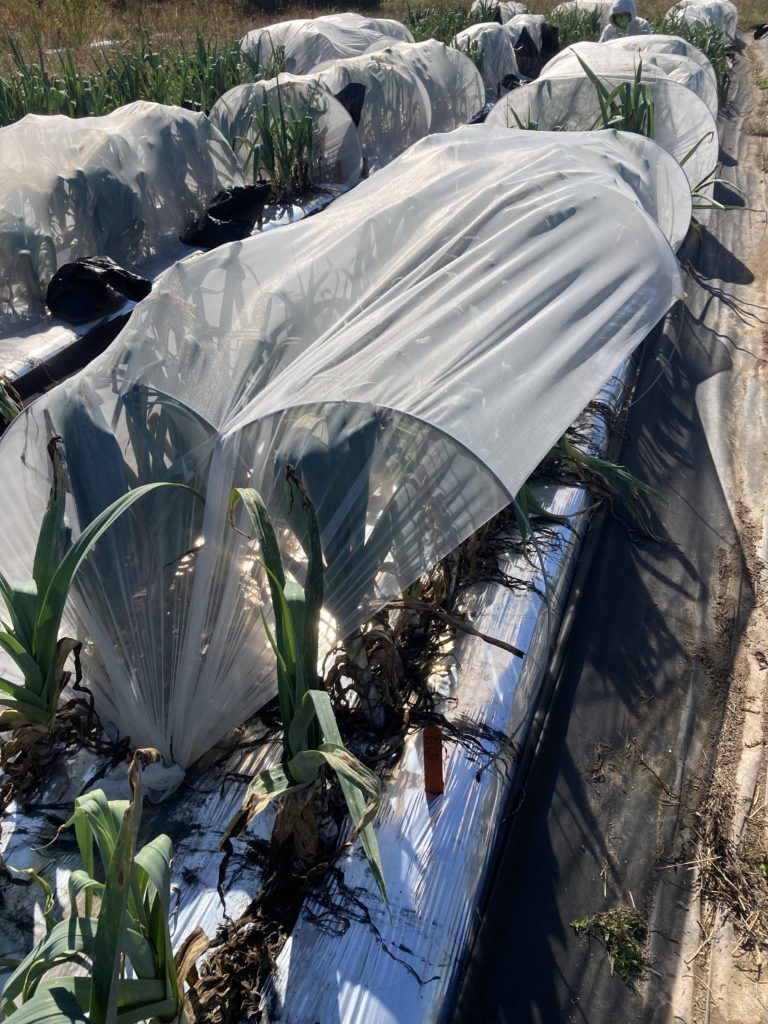
Disease Severity
The primary foliar diseases observed in the leek trial plots were botrytis leaf blight (Botrytis squamosa) and purple blotch (Alternaria porri). The percent of the total leaf surface with visible disease symptoms prior to trimming the foliage of 20 leeks per plot was evaluated at harvest. There was a statistically significant effect of treatment on disease severity in the trial (see graph for detail). The mean disease severity of leeks grown under ProtekNet with no hoops (REF+PN) was statistically significantly different from all of the other treatments with the lowest mean at 18.6%. The mean disease severity of REF+AGHPS, REF+PNHPS, and REF+AG were not statistically significantly different from another. For growers wishing to use either row cover or exclusion netting with hoops to exclude ALM from their leek crop, the data from this trial suggests that there is no risk of higher disease pressure under the row cover when compared to the exclusion netting. However, the trial data also suggest that leeks grown under exclusion netting without hoops may develop less foliar disease compared to leeks grown under row cover without hoops (18.6% mean disease severity compared to 26.7%; a difference of 8.1%).
The mean disease severity of the leeks in treatments REF, REF+AGLATE, REF+AGERLY, and REF+ENT were not statistically significantly different from each other and were numerically the most diseased leeks. There did seem to be some correlation between higher levels of ALM activity and higher incidence of foliar disease on the leeks.
Leek Height
The height of 20 leeks per plot was measured after the leeks had been uniformly trimmed at 6 inches above the top of the shaft (where the shaft ends and the leaves spread apart). There was a statistically significant effect of treatment on mean leek height in the trial (see graph for detail). The mean heights of the leeks grown in the REF+AGERLY, REF+AGHPS, REF+PN, and REF+PNHPS treatments were not statistically significantly different from each other and were the tallest leeks in the trial (17 inches, 16.5 inches, 16.5 inches, and 16.5 inches respectively). The leeks grown in the REF+AG plots (row cover without hoops) were numerically the shortest with a mean height of 15.9 inches. Part of the reason that the leeks in the REF+AG plots were shorter is the result of the distortion caused by the crop contacting the cover and restricting growth. As will be seen below in the section on marketable yield, many of the leeks in the REF+AG and REF+PN plots were noticeably curved.
Leek Weight
There was a statistically significant effect of treatment on mean leek weight in the trial (see graph for detail). The leeks grown in the REF+PN, REF+PNHPS, and REF+AGHPS plots were numerically the heaviest in the trial (0.622 lbs, 0.622 lbs, and 0.621 lbs respectively) and not statistically significantly different from each other. There were not, however, any clear trends to explain the differences in mean weights.
Percent Marketable Yield
The marketability assessments were made after stripping a few of the outer leek leaves during the dissection process to remove and quantify ALM larvae and pupae. One question that was raised during the assessments was whether a distorted leek that had curved in the REF+AG and REF+PN treatment plots would be considered marketable. After sharing images of the leeks with 5 organic leek growers, it was determined that the curvy leeks would be marketable so long as they met the other marketability criteria of size, disease, and visible ALM damage.
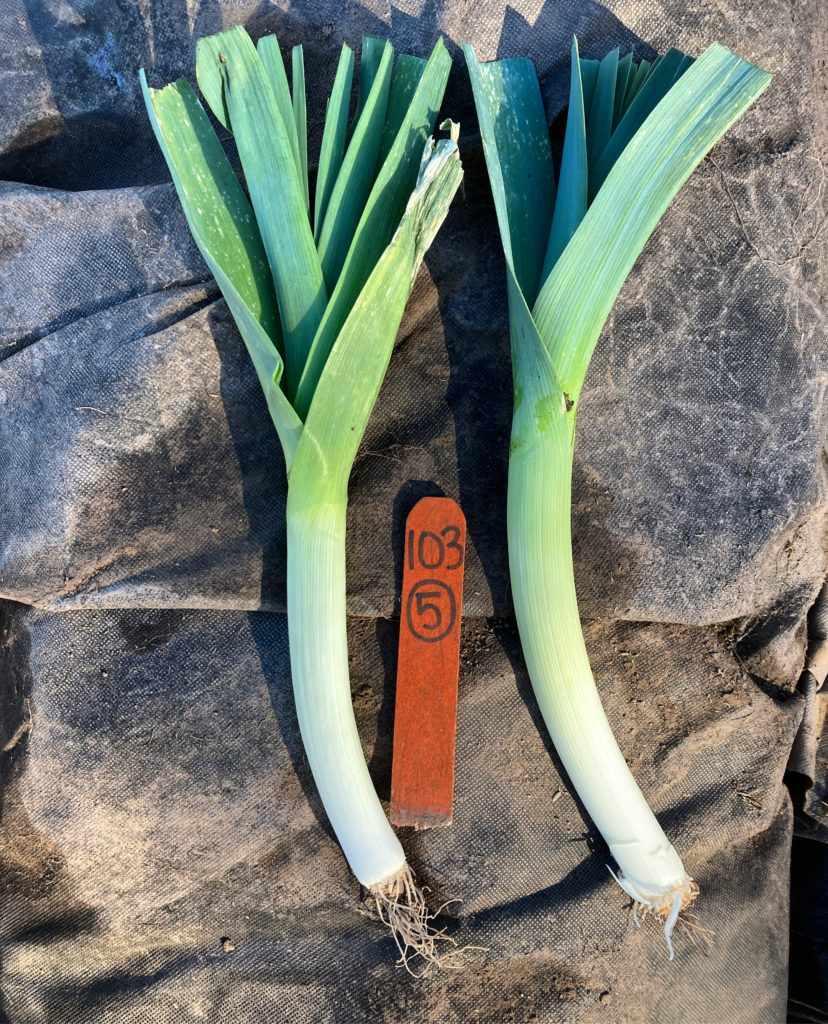
The most common cause for judging a leek to be unmarketable was the presence of ALM larvae and pupae in the shaft. The larval mining also creates physical damage in the plant tissue where bacterial soft rot pathogens often develop and further damage the plant.
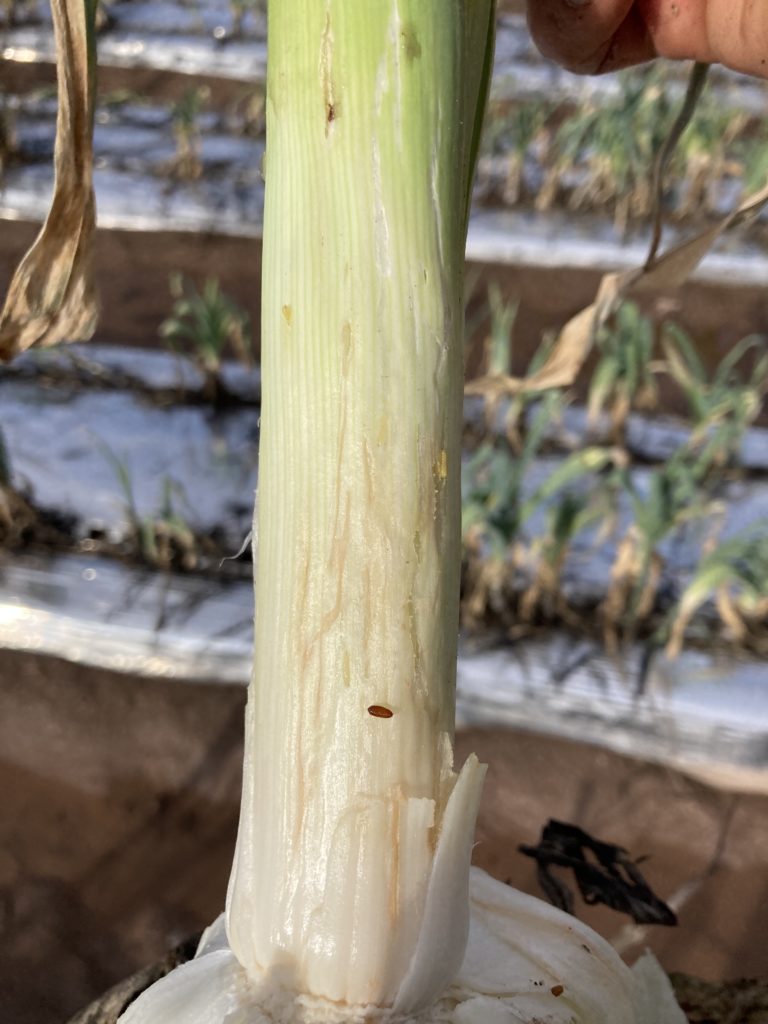
There was a statistically significant effect of treatment on the mean percent of leeks that were graded as “marketable” in the trial (see graph for details). Even though they were among the most distorted and the shortest in the trial, the leeks harvested from the REF+AG treatment plots were numerically the most marketable with 98% of the crop qualifying as marketable. The percent marketable yield in the REF+AG leeks was not statistically significantly different from the percent marketable yield in the REF+AGHPS (86%), REF+AGERLY (81%), REF+PN (80%), REF+ENT (73%), and REF+PNHPS (68%) treatments. Only the percent marketable yields in the REF+AGLATE (40%) and REF (13%) treatments were significantly different from the best treatments.
Despite lower disease pressure and taller plants in the REF+PN plots compared to REF+AG, there was not statistically significant difference in the percent marketable yield between the two treatments. The trial data suggest that the most important factor influencing crop marketability is the efficacy at reducing damage from ALM.
ALM Density
ALM pressure was very high in the fall leek trial and there was a statistically significant effect of treatment (see graph for detail). The densities were calculated by dissecting 20 leeks per plot and counting the number of ALM larvae and pupae in each leek. The mean ALM density in the leeks harvested from the REF treatment plots was the highest and significantly different from all other treatments at 33.8 larvae and pupae per leek. The second highest mean ALM density was recorded in the REF+AGLATE treatment plots (23.4), suggesting that waiting 2 weeks after the start of the ALM flight is not an effective strategy for reducing damage. The third highest mean (20.2) was found in the RE+PNHPS plots; this is almost certainly the result of the trouble described above keeping the edges of the ProtekNet anchored with the double hoop system. The fourth highest mean (11.2) came from the REF+AGERLY treatment plots, again suggesting that failing to keep the leeks well-covered for the duration of the ALM flight will likely result in higher levels of damage than is tolerable. The two applications of Entrust SC with M-PEDE in the REF+ENT treatment plots resulted in leeks with a mean ALM density of 7.7; a 77.2% reduction in ALM density compared to the REF treatment. Unfortunately, the mean density was still higher than tolerable in the treatment and contributed to the mean percent marketable yield of just 73% in the REF+ENT plots. The DeWitt row cover used in the REF+AGHPS treatment plots was a bit easier to anchor and, as a result, provided better protection to the leeks in those plots. The mean ALM density in the REF+AGHPS plots was 6.7, which was not significantly different from either REF+ENT or REF+PN (5.6). The most effective treatment at reducing damage from ALM in the trial was REF+AG. The mean ALM density per leek in the REF+AG plots was just 1.09. Again, though, growers should be aware that while using row cover without hoops made it easier to securely anchor the edges and keep ALM adults out of the plots, the practice did result in curvy leeks that some markets may not accept.
FALL 2021 LEEK TRIAL
Though replicating the fall leek trial in 2021 was not part of the original proposal, the researchers and partner farm felt it was important to evaluate the row cover treatments again given the challenges faced in adequately securing the narrow materials in 2020. ALM oviposition scars were observed on September 3, 2021 in the trial plots and early covers were installed on September 7, while the late covers were installed on September 20. Insecticide applications in the ENT+REF treatment plots were made on September 15 and September 29. Covers in the AGEARLY treatment were removed on October 5.
Treatment and Methods Changes
Wider ProtekNet insect netting and DeWitt .55 row cover were sourced to allow for more secure anchoring of the materials in the covered plots. 10-foot wide netting and row cover was used for the REF+PN, REF+PNHPS, REF+AG, REF+AGHPS, REF+AGLATE, and REF+AGERLY treatments and was secured using ground staples and sand bags.
Disease Severity
Disease pressure, especially Stemphylium leaf blight (Stemphylium vesicarium) was severe in the entire trial plot despite regular applications of several OMRI-listed fungicides. As a result of the high disease pressure, evaluations were made only on a per plot basis by estimating the percent of the foliage still green (without visible disease symptoms) on November 2, 2021. While there was no statistically significant effect of treatment on the percent green foliage at harvest (p=0.0571), there was a strong numeric trend toward higher disease pressure in the REF plots where ALM densities were also highest.
Leek Weight
Twenty harvested leeks per plot were trimmed and weighed together on November 2, 2021. There was no statistically significant effect of treatment on the mean weight per twenty leeks in this trial (p=0.69520).
ALM Density
ALM pressure was high again in Fall 2021. There was a statistically significant effect of treatment on the mean ALM densities in the Fall 2021 leek trial (p<0.0001). As was the case in 2020, the REF treatment plots had the highest average number of maggots and pupae per leek of any of the treatments at 22.4. All of the treatments that were covered either by the wider 10’ floating row cover (REF+AG, REF+AGHPS) or wider 10’ insect netting (REF+PN, REF+PNHPS) for the duration of the fall flight had lower mean ALM densities than in 2020, likely due to the fact that the wider materials were more easily and effectively secured along the edges to prevent ALM adults from entering the plots. In 2021, the REF+AGLATE treatment also performed fairly well with a mean ALM density of just 2.38 per leek. The low densities in the REF+AGLATE treatment in 2021 could be the result of the fact that there were fairly low levels of oviposition activity for over two weeks in the trial plot after first activity was observed on September 3. As was suggested by the Fall 2020 results, the REF+AGERLY treatment did not perform well in 2021 (10.1 maggots and pupae per leek). At this time, it is not advisable for growers to cover their leeks for only a portion of the ALM fall flight, though delaying cover for 7-10 days after the confirmed beginning of the flight period may not result in excessive damage. The REF+ENT treatment plots did have significantly lower ALM densities than the leeks in the REF and REF+AGERLY plots, but again failed to provide suppression to economically acceptable levels. The two Entrust + M-Pede applications only lowered mean ALM densities to 8.36 per leek, a 63% reduction compared to the leeks in the REF plots. Nevertheless, the majority of the leeks in the REF+ENT plots had high enough ALM densities to render them unmarketable.
Summary
The trial data suggests that both row covers and exclusion netting can effectively decrease ALM densities to tolerable levels in fall leeks without compromising crop yield, but only if those covers are left on for the entirety of the ALM flight. However, it is critical that growers using row covers or exclusion netting secure the edges well enough to prevent any gaps in the cover where ALM adults can gain access to the crop. Using row cover or exclusion netting without the use of metal hoops was just as effective at reducing ALM densities as using the materials with support hoops, but growers must assess whether the distorted curvy leeks that result will be accepted by their markets. While two carefully timed applications of Entrust SC with M-PEDE reduced ALM densities by 77% in 2020 and 63% in 2021 compared to leeks just planted on reflective plastic mulch, the mean ALM densities were still higher than most growers will tolerate in both years. More research is required to evaluate alternative OMRI-listed insecticides to add into a program along with 2 applications of Entrust with M-PEDE to provide growers who cannot reasonably use covers with an effective alternative for managing ALM.
This project sought to answer four questions regarding ALM management. Each will be addressed in order:
- Can the combined use of reflective mulch and two well-timed OMRI-approved insecticide applications serve as a viable alternative to the use of row covers to reduce damage from ALM on commercial farms in the northeast?
This trial data as well as data from 2018-19 suggest that two well-timed applications of Entrust SC with M-PEDE can significantly reduce ALM densities in leeks, but perhaps not to tolerable levels. The trial data from Fall 2020 and 2021 support the conclusion that two applications of Entrust SC with M-PEDE in combination with reflective mulch have failed to reduce mean ALM densities to acceptable levels. The use of well-secured insect netting or row cover for the entirety of the ALM flight provided a significant reduction in ALM densities compared to the use of OMRI-listed insecticides in both fall leek trials and is currently the most reliable method for organic leek growers to use to manage the pest.
2. What, if any, increase in marketable yield can allium growers in the region expect from the addition of two insecticide applications to the cultural control approach of just using metalized reflective mulch?
The addition of two well-timed applications of Entrust SC with M-PEDE significantly increased the marketable yield of fall leeks and significantly compared to leeks planted on reflective mulch with no insecticide applications (from 13% marketable yield in REF to 73% marketable yield in REF+ENT in 2020). There was also a significant reduction of 77.2% in the density of ALM per leek in the REF+ENT treatment leeks compared to the REF treatment leeks (7.7 ALM per leek from 33.8 ALM per leek) in 2020 and a 63% decrease in densities in 2021. However, the average number of ALM maggots and pupae per leek in the insecticide-treated plots was still unacceptably high in both 2020 and 2021.
3. Does the additional expense of purchasing insect exclusion netting result in an increase in marketable allium yield when compared to the use of floating row cover to protect plants from ALM adults?
There was no statistically significant difference in any of the yield or marketable yield measurements between the ProtekNet treatments and the DeWitt 0.55 row cover treatments in the spring scallion trial. Though there was a statistically significant reduction in foliar disease severity in the REF+PN treatment leeks compared to the REF+AG treatment leeks in the fall of 2020, there was no significant impact of that reduced disease severity on the percent of the leek crop that was marketable. There was no statistically significant difference in marketable yield between the exclusion netting with hoop treatment leeks and row cover with hoop treatment leeks, either in 2020. The trial data from fall 2020 and 2021 suggests that there is no clear benefit to using insect exclusion netting instead of floating row cover to exclude ALM adults, so long as the covers are wide enough to be securely anchored over the crop.
4. Can growers apply row covers to allium crops for only a portion of the adult ALM flight to reduce negative impacts to yield and quality while maintaining protection from ALM damage?
The late cover and early removal of row cover treatment leeks had significantly higher ALM densities when compared to the leeks that were covered with row cover for the duration of the fall ALM flight in both 2020 and 2021. The trial data suggest that it is not advisable to cover leeks late or remove covers before the end of the ALM flight as there was no significant increase in crop height, crop weight, and marketable yield, or decrease in disease severity by limiting the length of time that the leeks were covered.
Education & Outreach Activities and Participation Summary
Participation Summary:
The formal education and outreach activities related to this project are described in more detail below:
Farmer Consultations
Teresa Rusinek and Ethan Grundberg advised at least 60 allium growers in the Northeast, primarily in New York, on allium leafminer management over the duration of the grant period.
Curricula, Factsheets, or Educational Tools
Podcast
“Allium Leafminer (ALM) Update.” Eastern NY Vegetable News Podcast. April 8, 2021. 47 minutes. https://soundcloud.com/easternnewyorkvegnews/allium-leafminer-alm-update . 122 listens as of 2/25/2022.
On-Farm Demonstrations
The research trial was conducted on farm at Row By Row in Hurley, NY. The owner operators, Mira and Dakota Miller, as well as other extension professionals (Katie Campbell-Nelson, Crystal Stewart-Courtens, and Chuck Bornt) visited the trial plots on several occasions to discuss preliminary findings and ALM management more broadly.
Published Newsletter Articles
Rusinek, T and E Grundberg. “Managing Allium Leafminer: Top 10 Research Takeaways.” Eastern New York Produce Pages. March 2021 pp. 4-5. https://rvpadmin.cce.cornell.edu/pdf/enych_newsletter/pdf505_pdf.pdf. Distribution: 596
Grundberg, E. “Preparing for the Fall Flight of Allium Leafminer.” Eastern New York Vegetable News. August 25, 2021. https://rvpadmin.cce.cornell.edu/uploads/doc_990.pdf. Distribution: 596
Grundberg, E. “Preparing for the Fall Flight of Allium Leafminer.” UMass Extension Vegetable Notes. September 9, 2021. Pp. 4-5. https://ag.umass.edu/sites/ag.umass.edu/files/newsletters/september_9_2021_vegetable_notes.pdf. Distribution: 2800
Webinars, Talks, and Presentations
Grundberg, E. Southern New England Vegetable Growers Meeting Series: Pests of the Year. “Allium Leafminer: A New Invasive Pest of Allium Crops in the Northeast.” January 15, 2021. 293 live attendees. https://www.youtube.com/watch?v=IadfeJ1dWVo . 238 views as of 2/25/2022.
Grundberg, E. New England Vegetable and Fruit Conference: Vegetable Pest Updates. “Allium Leafminer: A New Invasive Pest of Allium Crops in the Northeast.” December 15, 2021. 244 live attendees.
Number of Farmers Participating in Outreach
It is estimated that 3,518 farmers were reached through the efforts described above (2800 UMass Vegetable Notes distribution + 596 Eastern NY Vegetable News distribution + 122 listens to the Eastern NY Vegetable News Podcast episode). It was assumed that the growers attending the webinars and watching the YouTube recording of the webinars were already counted as subscribers to the newsletters where articles were published.
Learning Outcomes
Farmers were not formally surveyed as part of this project to evaluate changes in knowledge, attitude, skills, and/or awareness.
Project Outcomes
The methods utilized in the research conducted with support from Northeast SARE were sound. The only change that could have made more efficient use of time and resources would have been to eliminate the spring 2020 trial in favor of more extensive trialing during the more damaging fall flight periods. Nevertheless, the data collected from the three separate trials conducted as part of this project did provide clear answers to the research questions articulated in the proposal and summarized in the research findings section, at least for informing ALM management tactics during the fall flight. As a result of the research, the team intends to advocate primarily for the use of floating row cover or insect exclusion netting to manage ALM on organic farms growing fall alliums. The trials did highlight the need for continuing research on a number of aspects of ALM management for organic growers, specifically:
- Can the addition of a third and/or fourth application of an OMRI-listed insecticide in sequence with two applications of Entrust SC co-applied with M-PEDE provide an improve ALM suppression to acceptable levels in fall grown leeks? If so, are the additional insecticide applications cost effective?
- Is there any benefit to using reflective plastic mulch on fall leeks if row covers or insect netting are to be used to exclude adult ALM during the fall flight? What are the impacts on leek yield, quality, and other pest pressure of the reflective mulch compared to black plastic mulch, white plastic mulch, and or bare ground production?
- Are there alternative cost-effective materials other than the 76" metal hoops that growers can use to support row covers or insect netting in tall-stature crops like leeks that must be covered for over 6 weeks?
- Are there other cultural control tactics that may help growers reduce their level of damage from ALM? For example, would deep moldboard plowing to bury pupae after fall infestations have any significant impact on damage to allium crops in the subsequent year?
As ALM continues to spread throughout the Northeast and Mid-Atlantic, organic growers encountering this new pest and those extension staff and private consultants supporting them should benefit from the information generated through these research trials.
